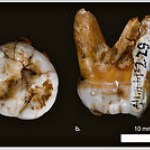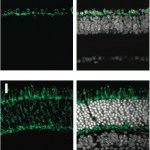evolution
When last we left this subject, I had pointed out that the phenomenon of embryonic similarity within a phylum was real, and that the creationists were in a state of dishonest denial, arguing with archaic interpretations while trying to pretend the observations were false. I also explained that constraints on morphology during development were complex, and that it was going to take something like a thorough comparative analysis of large sets of gene expression data in order to drill down into the mechanisms behind the phylotypic stage.
Guess what? The comparative analysis of large sets of…
David Reich/Nature
The entire genome of the Denisovans was extracted from a tooth and finger bone.
The film "Little Fockers" is coming out this week, and I look forward to brilliant performances from Robert DiNero, Ben Stiller, Dustin Hoffman and Barbra Streisand to name a few. If you will excuse my cheekiness, I thought of this dysfunctional family when I learned today of the "Denisovans". Let me explain.
The human tree of life appears to have a new branch: cousins of the Neanderthals, the "Denisovans". The New York Times reporter Carl Zimmer has had a busy week. First, he reported…
In a stunning finding, scientists found evidence in northern Spain of cannibalism by Neanderthals. Some 1,800 bone fragments were used for DNA analysis to support their hypothesis. According to The New York Times report,
Spanish scientists who analyzed the bones and DNA report the gruesome answer. The victims were a dozen members of an extended family, slaughtered by cannibals.
It seems common knowledge that Neanderthals were lacking in refinement by modern standards, but this is a bit much. This is indeed "food for thought", since there is evidence that part of our genome is inherited…
I had intended to devote this post to Michael Ruse's latest column for HuffPo. It turns out, though, that first we need to consider this earlier column from Ruse.
When I first started writing about evolution and creationism I took a highly accommodationist line. I was perfectly happy to parrot the conventional wisdom that evolution and Christianity were compatible and that only crazy extremists think differently. Of course, my current view is not nearly so ecumenical. Today I believe that while it is not flatly impossible to reconcile them, it is at least far more difficult than is…
NOTE: Orac was actually out rather late last night. It turns out that the more administrative responsibility he somehow seems to find the more he has to go out to dinner as a part of various cancer center-related functions. As a result, he is recycling a bit of recent material from elsewhere that he in his extreme arrogance considers just too good not to post up on this blog too. In any case, it's always interesting to see how a different audience reacts to his stuff, and he did make some alterations to this post.
'Tis the season, it would seem, for questioning science. Not that there's…
This is a familiar creationist argument, stated in this case by a non-creationist:
Consider the replacement processes needed in order to change each of the resident genes at L loci in a more primitive genome into those of a more favorable, or advanced, gene. Suppose that at each such gene locus, the argument runs, the proportion of gene types (alleles) at that gene locus that are more favored than the primitive type is Kâ1. The probability that at all L loci a more favored gene type is obtained in one round of evolutionary "trials" is KâL, a vanishingly small amount. When trials are carried…
Has it really been six years?
Six years ago today, on a dim and dreary Saturday in December, almost on a whim I sat down, went to Blogspot, and started up the first version of Respectful Insolence with an introductory post with the cliched title, Please allow me to introduce myself. Here it is, six years later. On this cold December Saturday, I still find it difficult to his blog is considered one of the "top" medical blogs by one measure, and some actually--shockingly--consider me somewhat of a "famous" skeptic. I know, I know, I still can't wrap my head around the concept myself. At least,…
Evolution connects all living things on earth, from the arsenic tolerant bacteria in the news this week to the human scientists and bloggers chatting about it. Eyes are intricately complex structures made up of many many cells, but even single-celled microbes can sense and respond to light through the function of proteins that share evolutionary similarity with the light receptors of the human retina. Incredibly, genetic engineering is showing us just how similar these proteins can be--transferring the genes that code for these processes leads to functional proteins, even when huge…
An incredible (if unscientific) look at the history of life:
The video has been around for a few months and has a gajillion hits so sorry if I'm late to the party, I just had to share!
By Blu, via Bio Fiction
Glance back at this post for a refresher on what Im going to write about here.
Quick recap:
HIV-1 usually evolves around this to 'hide' from CTLs. Maybe it puts a sombrero on the skull so the CTLs think its a party boat. But while HIV-1 evolves ways to hide from cytotoxic T-cells, this escape comes at a fitness cost. So if the sombrero-pirate-flag-HIV is transmitted to someone with a different MHC type whos CTLs couldnt see that pirate flag in the first place, HIV-1 is going to take off the sombrero and regain fitness.
The Problem: HIV-1 is figuring out how to evade CTLs... while maintaining…
Oh, great. I get to be the wet blanket.
There's a lot of news going around right now about this NASA press release and paper in Science — before anyone had read the paper, there was some real crazy-eyed speculation out there. I was even sent some rather loony odds from a bookmaker that looked like this:
WHAT WILL NASA ANNOUNCE?
NASA HAS DISCOVERED A LIFE FORM ON MARS +200 33%
DISCOVERED EVIDENCE OF LIFE ON ONE OF SATURNS MOON +110 47%
ANNOUNCES A NEW MODEL FOR THE EXISTENCE OF LIFE -5000 98%
UNVEILS IMAGES OF A RECOVERED…
I have a whole pile of science-y book reviews on two of my older blogs, here and here. Both of those blogs have now been largely superseded by or merged into this one. So I'm going to be slowly moving the relevant reviews over here. I'll mostly be doing the posts one or two per weekend and I'll occasionally be merging two or more shorter reviews into one post here.
This one, of The Science of Evolution and the Myth of Creationism: Knowing What's Real and Why It Matters, is from June 8, 2007.
=======
The whole raison d'etre of this book is to counter creationists' arguments against…
I guess Im going to have to change the name of 'ERV'.
Before I was just concerned.
Now, ERVs are officially not so special at all.
Viruses, all kinds of viruses, are all over the place in genomes-- from insects to humans.
Endogenous Viral Elements in Animal Genomes
Carl Zimmers take: Your inner viruses: the trickle becomes the flood
My quick-and-dirty take:
Every form of virus-- retrovirus, ssRNA(-), ssRNA(+), dsRAN, dsDNA, ssDNA-- every form of virus has an endogenous component now.
Theyre all over the place. Every organism has these 'alternative' endogenous viruses. Theyre inserted all…
The last common ancestor of plants and animals may have lived 1 billion years ago. Plants and animals have occasionally exchanged genes, but for the most part, have countered selective pressures independently. Microbes (bacteria, eukaryotes, and viruses) were omnipresent threats, influencing the direction of multi-cellular evolution. Receptors that detect molecular signatures of infectious organisms mediate awareness of non-self, and are integral to host defense in plants and animals alike. The discoveries leading to identification of these receptors and their ligands followed a similar…
Even though the real ERV is a) hiding in an undisclosed location and b) blinded by a week long migraine from this stress, you can still enjoy me via video taken at the Texas Freethought Convention!
First of all, that was an absolutely fantastic introduction. I loved it! I felt like a total ass for changing my topic at the last minute :-/
Aaaaaand I was totally terrified. The largest group of normal people I think Ive talked to, ever. And not just normal people. Normal people who really like science and were really excited to learn something new. My inner thoughts as I was walking up the…
The endogenous retroviruses in your genome are dead.
Dead.
Junk.
They no longer code for functional, infectious viruses.
Those viruses are also extinct. They were floating around thousands, millions of years ago, infecting stuff, and now they are hanging out in your genome instead (100% of humans are infected, *wink*).
ERVs are viruses that we have, functionally, tamed. We have overcome them.
Thus, it would be useful to 'bring ERVs back to life' so we can study them and figure out how we conquered them, hopefully giving us idea how to treat modern day infections.
"OMFG!" a crazy person…
A few weeks ago, I read an article in Wired talking about an amazing new project led by E.O. Wilson: an all-digital, not-for-profit textbook called Life on Earth. It looks amazing, and it's going to be offered to K-12 schools for free.
Neil Patterson, director of Life on Earth with 50 years of science textbook publishing experience to his name, said the format could revolutionize science education for students.
"Motion and film are powerful ways of teaching," Patterson said. "We're trying to exploit the human brain, like videogames do, and it's not a small matter to use technology now…
One of the great things about having declared Vaccine Awareness Week is that it gives me a convenient excuse to revisit topics and blog posts that I had meant to address but that somehow didn't make the cut the first time around. This is the sort of thing that happens fairly frequently in blogging, where there is far too much woo and idiocy for one blogger to have even a hope of ever addressing it all.
And that's just the anti-vaccine movement.
In any case, if there's one thing about the anti-vaccine movement that I've noticed, it's that its members have a very warped view of both science and…
Researchers in Maryland have discovered an interesting quirk: lung smooth muscle expresses on its surfaces a protein that is the same as the bitter taste receptor. This could be useful, since they also discovered that activating that receptor with bitter substances causes the muscle to relax, opening up airways, and could represent a new way to treat asthma. That's a fine discovery.
But man, it really tells us something about human psychology. I'm getting all this mail right now, and just about all of it asks the same question: Why do lungs have taste receptors? What is the purpose of sensing…
Right now on Discovery…it's First Life with David Attenborough, which is supposed to be about the origin of life on Earth. There's a pretty severe metazoan bias, unfortunately, so it's really about the origin of animals, but still it's cool stuff about the Cambrian.


